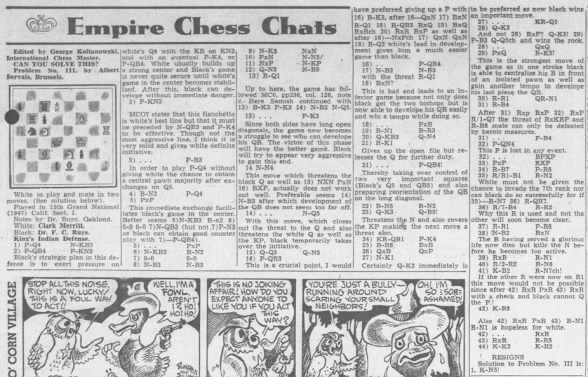 Chess Chats 06 Nov 1949, Sun The Press Democrat (Santa Rosa, California) Newspapers.com
Chess Chats 06 Nov 1949, Sun The Press Democrat (Santa Rosa, California) Newspapers.com
Chess Chats by George Koltanowski Sunday, November 06, 1949 The Press Democrat Santa Rosa, California Problem No. 110...
Posted by Bobby Fischer's True History on Wednesday, March 25, 2020
Problem No. 110 by O. Kolberg, Norway. White to play and mate in two moves.
FEN 8/p1rP4/1rp2P2/RnN4R/3k1K2/p1b1NpQ1/3pb2B/8 w - - 0 1
Played in 15th Grand National (1947) Calif. Sect. I.
Notes by Dr. Ruys, Oakland.
Clark Merritt (white) vs. Dr. Frank C. Ruys (black)
Neo-Grünfeld Defense: Ultra-delayed Exchange Variation
2. Black's strategic plan in this defense is to exert pressure on white's Q4 with the KB on KN2 and with an eventual P-K4, or P-QB4. White usually builds up a strong center and Black's game is never quite secure until white's game in the center becomes stabilized. After this, black can develop without immediate danger.
3. MCO7 states that this fianchetto is white's best line but that it must be preceded by N-QB3 and P-K4 to be effective. Though not the most aggressive line, I think it is very solid and gives white definite initiative.
In order to play P-Q4 without giving white the chance to obtain a central pawn majority after exchanges on Q5.
5. This immediate exchange facilitates black's game in the center. Better seems 5. N-KB3 B-N2; 6. O-O O-O; 7. N-QB3 (but not 7) P-N3 as black can obtain good counter play with 7. P-QB4.
13. Up to here, the game has followed MC0, pp236, col. 126, note c. Here Samish continued with 13. B-K3 P-K3; 14. N-B3 N-Q5.
Since both sides have long open diagonals, the game now becomes a struggle to see who can develop his QB. The victor of this phase will have the better game. Black will try to appear very aggressive to gain this end.
14. This move which threatens the black Q as well as 15. NxN PxN; 16. BxP, actually does not work out well. Preferable seems 14. N-B3 after which development of the QB does not seem too far off.
With this move which closes out the threat to the Q and also threatens the white Q as well as the KP, black temporarily takes the initiative.
16. This is a crucial point, I would have preferred giving up a P with 16. B-K3 after 16…QxN; 17. BxN R-Q1; 18. B-QB3 RxQ; 19. BxQ RxRch; 20. RxR BxP as well as after 16. … NxPch 17. QxN QxN; 18. R-Q2 white's lead in development gives him a much easier game than black.
17. with the threat R-Q1
18. This is bad and leads to an inferior game because not only does black get the two bishops but is now able to develop his QB easily and win a tempo while doing so.
21. Gives up the open file but releases the Q for further duty.
Thereby taking over control of two very important squares (Black's Q5 and QB5) and also preparing reorientation of the QB on the long diagonal.
23. Threatens the N and also covers the KP making the next move a threat also.
27. Certainly Q-K3 immediately is to be preferred as now black wins an important move.
28. And not 28. RxP? Q-K5! 29. P-B3 Q-Q5ch and wins the rook.
29. This is the strongest move of the game as in one stroke black is able to centralize his B in front of an isolated pawn as well as gain another tempo to develop his last piece the QR.
31. After 31. RxP RxP 32. RxP R/1-Q7 the threat of RxKRP and R-R8 mate can only be defeated by heroic measures.
32. This P is lost in any event.
35. White must not be given the chance to invade the 7th rank nor can black do so successfully for if 35. … R-N7 36. R-QR7.
36. Why this R is used and not the other will soon become clear.
38. The B having served a glorious life now dies but kills the N before he becomes too active.
41. If the other R were now on R1 this move would not be possible since after 42. RxR PxR 43. RxR with a check and black cannot Q the P!
42. Also 42. RxR PxR 43. R-N1 R-N1 is hopeless for white.






















